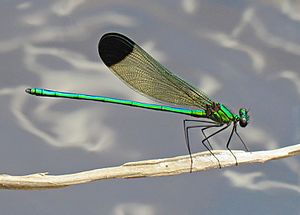Sparkling jewelwing facts for kids
Quick facts for kids Sparkling jewelwing |
|
|---|---|
 |
|
| Conservation status | |
| Scientific classification | |
| Kingdom: | |
| Phylum: | |
| Class: | |
| Order: | |
| Suborder: | |
| Family: |
Calopterygidae
|
| Genus: | |
| Species: |
C. dimidiata
|
| Binomial name | |
| Calopteryx dimidiata Burmeister, 1839
|
|
| Synonyms | |
|
|
The sparkling jewelwing (Calopteryx dimidiata) is a beautiful type of damselfly. It belongs to a family called Calopterygidae. This special insect only lives in the eastern and southeastern United States. You can usually find it in forests and open areas. It likes to be near rivers and streams.
What Does It Look Like?
The sparkling jewelwing is one of the smaller damselflies in its family. It grows to be about 37 to 50 millimetres (1.5 to 2.0 in) long. Its body, including its chest (thorax) and long, thin belly (abdomen), is a shiny bluish-green color. Its eyes are brown.
Male sparkling jewelwings have a unique look. The last fifth of each of their wings is black. A straight line separates this dark part from the clear, see-through part of the wing.
Female sparkling jewelwings are a bit more bronzy-green. Their wings might look like the males' but the black parts are less clear. Sometimes, only their back wings have black tips. Other times, their wings are completely clear. Both males and females usually have a small white spot near the tip of their wings. This spot is called a pterostigma. Young adults have reddish eyes and their colors are not as bright.
Male sparkling jewelwings have front and back wings that are almost the same size. The difference is usually less than 2 millimetres (0.08 in). The very end of both pairs of wings has a black band. This band ends in a straight line. These features help tell them apart from other damselflies in the same group.
Where Does It Live?
The sparkling jewelwing lives in the eastern and southeastern parts of the United States. You can find it from New England down to Louisiana and parts of Texas. It mostly lives along the Atlantic coastal plain.
It prefers sandy forest streams. These streams are often a bit acidic. The water in these places flows quickly. The damselflies also like areas with lots of plants growing along the riverside.
Life and Habits
Sparkling jewelwings are active for different parts of the year. In New Jersey, you can see them flying from May to September. In Florida, they fly for a longer time, from February to November.
Males and females are often seen together near places where they lay eggs. Males will fly around a small area, which they consider their territory. They will chase away other males that come too close.
When a female is nearby, the male will perform special courtship flights. These flights happen before they mate. Mating usually lasts for about two minutes. After mating, the female walks down the stem of a plant that is growing in the water. She goes underwater for about fifteen minutes. There, she lays hundreds of eggs before coming back to the surface.
- NatureServe. 2015. Calopteryx dimidiata. NatureServe Explorer. Version 7.1. Accessed: January 20, 2016.


